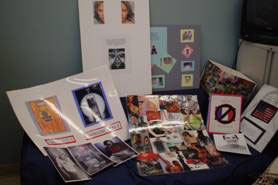
Picturing Work:
Visual Projects in the Writing Classroom
by Virginia Kuhn
At its November 1997 meeting, the board of the National Council of Teachers of English debated the importance of non print texts in a global society, a discussion sparked by the group’s “growing consciousness of how people gather and share information.” Following the discussion, the NCTE adopted a Statement on Visual Literacy entitled, “On Viewing and Visually Representing as Forms of Literacy,” a resolution whose background statement says, in part, “[t]eachers and students need to expand their appreciation of the power of print and nonprint texts. Teachers should guide students in constructing meaning through creating and viewing nonprint texts” (Reprinted in Kairos, 2.1).
Two features of this initiative bear mention and are closely related. One is that the need for visual literacy is firmly tied to events and circumstances in the world; that is, that the ideals and practices we profess in the academy are inextricably linked to students’ lives and issues of access to societal power. While this has always been the case in literacy initiatives, in an information society, unlike in an industrial one, the line between technology used for work and for leisure is increasingly blurry and so is the line between users and producers, amateurs and experts (Manovich 35). That is to say, the 21st century, which is distinctive in the growing ease with which visual texts are produced, altered, and disseminated due to emergent technologies, creates a situation in which English scholars in general, and writing scholars in particular question not only the relationship between word and image, but also the primacy of the former over the latter.
Thus, the second and corollary feature of this resolution’s significance lies in its call for focusing not only on understanding visual texts but on producing them as well. The concern with visuals in composition is certainly not new, yet there is something radically different about today's social, political, and economic climate that has made the interest more pressing. While no writing teacher appears ready to supplant written texts with pictorial representations, a small but growing faction contends that “competent control” of images—the ability to not only interpret but to produce visual arrangements—is a crucial component of visual literacy, and, perhaps more profoundly, a necessary feature of literacy in general.
Although visual production is an increasingly prevalent topic found in composition journals and textbooks over the eight years following the NCTE resolution, as one prominent compositionist contends, “there remains much confusion over what is meant by visual communication, visual rhetoric, or, more simply the visual and where or whether it belongs in a composition course” (George 13, italics original).
Because composition studies concerns itself, first and foremost, with the education of university students, it faces the rather daunting task of promptly translating its theories into pedagogical strategies and often these teaching experiences lead to new questions for scholarship. There is a close connection between theory and practice and yet, historically speaking at least, there is always a gap between theory and practice. Indeed it was my research into theories of visual literacy that initially compelled me to integrate visual production in a class, and, in turn, it was my difficulty in articulating, assigning and assessing the actual projects which crystallized the need for further inquiry, prompting me to pursue this area in greater depth. But Composition Studies is, ultimately, a print-based discipline and, as such, I had to overcome my own preconceptions about what an image could accomplish in a composition before I could revise my pedagogical approach.
The bias against images often stems from the misguided view that they do not contain the sort of “double articulation” that words do. Words are comprised of arbitrary signifiers—there is little correlation between the letters used and the thing to which they refer—whereas images do not seem to contain that extra component of translation and, as such, are not considered to be language. They are seen merely as a copy of something real and they do not require complex interpretive strategies. Obviously though, any visual—whether drawn, painted, photographed or rendered in pixels on a computer screen—uses two dimensions to represent a three dimensional object, requiring the viewer’s abstraction. It follows then, that if two texts, one visual and one verbal, have the same degree of complexity, the cognitive demand of working with them will be similar.
Having done undergraduate work in art history and criticism, and having spent three years working as a member of the writing program administration team at a large public university, I found it relatively easy to incorporate the analysis of visuals in my writing courses; however, when it came to guiding the creation of visual projects, I was at somewhat of a loss.